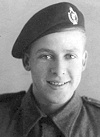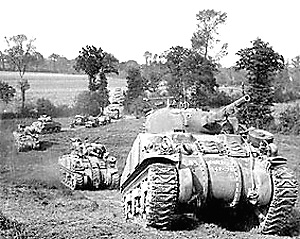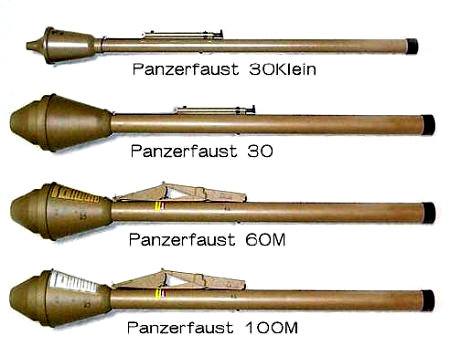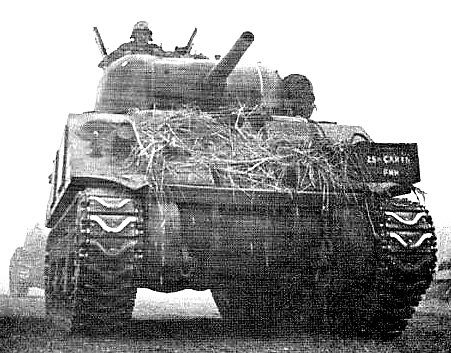|
Trooper Sydney Moore's Sherman
Tank is hit
Operation Totalize 8th August 1944


8th AUGUST 1944 – Operation Totalize
After the tank regiment found its way over the railway all sense of tactical organisation and positioning in the advancing column had disappeared. It was now about 2am. Squadron and Troop tank commanders had to halt his tanks and regroup them before moving off again. As the tanks arrived at what the commanding officer estimated to be the debussing area for the infantry, by counting the hedgerows he had passed and comparing them with an aerial photograph, he called all tanks to halt. A group of tanks, lead by second-in-command Major Thomas Lovibond, who had taken a slightly different route to the main group found themselves too close to the Village of Cramesnil. Major Lovibond’s tank was hit by a Panzerfast rocket and brewed up. He was killed. Lieutenant Commander Colonel Alan Jolly called the rest of the tanks back and to wait for infantry support. They were attacked by nebelwerfer or Moaning Minnie as the British called this rocket firing German weapon. It was probably fired from the nearby village. Heavy missiles started to fall all around the tanks, throwing up clouds of earth and black smoke. They did not cause any damage or injury .

The Panzerfaust is a WW2 German Infantry handheld Anti-Tank Weapon
It was now 3am. Odd Germans were seen appearing out of the corn and giving themselves up to the infantry who had recently debussed from their transport vehicles. As the soldiers passed the tanks heading towards the village of Cramesnil the tankers noted that they appeared confident and had a phlegmatic manner. It gave the tank crews a considerable sense of relief. Tanks can’t work on their own. They need ground support. The troops seemed to know where they were going.
The tank crews formed themselves into a rough ‘close leaguer’ for all round defence while waiting for reports from the infantry units that the village was clear. After about 20 minutes Sid’s Sherman tank was hit. Sid had been awake for over 24 hours since the start of Operation Totalize. He said that he was exhausted. He had not had much sleep and was sitting in the tank, leaning forward, resting when the tank was hit. If he had been sitting up properly he would have been killed.
His commanding officer Lieutenant Commander Colonel Alan Jolly
noted "… there was another of those now all too familiar showers
of sparks and one of the tanks in the leaguer began to burn.
This is perhaps the worst moment of all. We were a perfect
target huddled together in the field, the black outlines of the
tanks clearly visible in the moonlight. The shot had come from
behind us so perhaps some enemy tanks unseen in the dark, had
trailed the column. We waited in suspense and one wondered, selfishly, whether one’s own tank would be next to be hit. But there were no other incidents and we never solved the mystery of that last shot. It is even possible that it came from a tank of a neighbouring allied column, lost in the darkness and mistaking us for enemy tanks. Whatever the explanation, four of our men were killed – Corporal A Skinner and Troopers T. Parker, R. Smith ‘10’ and J. Heren. Trooper Sid Moore was wounded but escaped.’
(The shot might have come from the third German Panzer tank that
retreated into the darkness at the earlier engagement by the gap
in the hedge. As it was a single shot it could also have come
from a hand held single shot German infantry Panzerfaust
Anti-tank weapon)

The tank caught fire. Sid managed to pull himself out even though he had suffered serious damage to his right leg. His hands and body were seriously burnt as the Sherman tank caught fire and 'brewed up'. The Sherman Tank had the nick name of 'the Ronson' after the lighter company because it caught fire so quickly. He yelled at the rest of the tank crew to get out; not knowing that they were dead. The metal body of the tank was red hot. Both his hands were melting as he tied to pull his body out of the hatch. He was in agony. His skin on his hands was peeling off. He fell to the ground from the top of the tank. He didn't understand why he could not stand up. He did not realise how badly his leg was injured. Sid's problems did not end there. The kilt wearing 7th Argylls & Sunderland Highlanders were passing the tanks on way to attack the village of Cramesnil . He knew they would bayonet anything that moved and ask questions later. It was dark but his position was illuminated by the light from his burning tank. All he could think of was to abuse them by insulting their Scottish heritage and shout out the code word, the name of a Scottish Comedian Harry Lauder. They realized he was an English Sassenach. So rather than stab him with cold steel he just received a kick as they ran past towards the front line.
At 3.30am a heavy ground mist floated over the countryside which would help hid the tanks from the enemy. In preparation for deployment to help the infantry take the village of Cramesnil C Squadron was told to go to the right, B to the left and A to the rear. They weren’t required because at 5.30am news came that the infantry had captured the village. They had killed eight and captured forty Germans for the loss of three of their own soldiers killed and nineteen wounded. At the same time they heard that the 5th Camerons had come up and occupied the nearby objective Lorguichon Wood.
The mist cleared about 8am and the day turned into another fine day with a cloudless sky. The tank crews looked at each other and were faintly surprised at seeing so many familiar faces still alive. Whislt having a brew of tea one of the troopers commented “Once or twice I didn’t think we’d be having any more brews of tea, but here we are”. Out of the chaos and anxiety of the night had come success. Their weariness gave way to feelings of exhilaration.
Whilst Sid was being transported back to the forward Medical post his regiment moved on. B Squadron moved up in support of the infantry to a position on high ground immediately west of the village of Cramesnil. A and C Squadrons were in kept in reserve with the Regimental HQ just south of the recently captured Lorguichon Wood. On the left the rest of the brigade had been successful in reaching their mornings objective. After an eventful journey the 1st Northamptonshire Yoemanry with the 1st Black Watch had captured St. Aigman de Cramesnil, and 148th R.A.C h Black Watch hwith the 7 d reached Garcelles Secqueville without opposition.
The Canadians on the west side of the road, reached their objective by dawn. The high ground designated point 122. They too had lost direction in the night and run into opposition. They repulsed an enemy tank counter attack but had taken some casualties. The British units could see a Canadian tank blazing among some scrub on the skyline near point 122. The capture of this high ground enabled the Allies to quickly widen the corridor that had been forced through the enemy held territory the night before. Pockets of resistance had to be dealt with. The village of Tilly-la Campagne had been by passed in the night as it was considered too strongly defended. It now had to be cleared. There were a lot of British casualties before the Germans finally surrendered the village.
From the tank regiment’s point of view the night attack had been very successful in its outcome. Instead of being faced with the prospect, as in the past, of having to advance across open ground while the enemy waited concealed and stationary on dominating ground, able to take well aimed shots, now the tables were turned. That is what happened on the morning of the 8th. The German armour counter attacked twice but were forced to with draw because they came under fire from concealed stationary allied guns and tanks on the high ground. It was in this way that the 144th Tank regiment helped open the first crack in the German defences guarding the approaches to Falaise. It was the first blow followed by others that eventually lead to the battle of the Falaise Gap where the German army retreated from advancing Allied forces.
Operation Totalize was noted as the first allied offensive that used armoured personnel carriers that would revolutionise infantry tactics. These vehicles were called “kangaroos”. The quickly demonstrated that by giving the infantry an armoured vehicle in which to travel they could be saved the many casualties which occur from machine gun fire, shelling and mortars. Though the final battle had to be carried out on foot the moral effect of coming fresh to the battle field and being saved unnecessary casualties was considerable. The ability to accompany tanks in mobile operations and follow them through light opposition without dismounting also had tactical results on many occasions. It is just a shame that it had taken the Allies so long to start to use them. The Germans had used similar vehicles in the Blitzkrieg attack on the Low countries and France at the beginning of the war in 1939.
The German infantry were equipped with good tank defences. They had their own anti-tank guns, self propelled anti tank guns on loan from a Panzer corps, a number of 88mm guns of the flak brigade, artillery mortars and rocket firing Nebelwerfers. All concealed waiting for the expected attack. The tactical use of darkness to avoid the aimed fire of German anti-tank guns was an innovation but many did not want to repeat it because of all the chaos and confusion. Nevertheless it did achieve the desired success which would have been impossible in the daylight with so few casualties.
The problems during the attack arose for the lack of training in night operations, the lack of an accurate and reliable aid to direction keeping in bad visibility and the lack of a means to shoot without giving away your position. Before the war it was assumed that tanks could not operate at night.

Books that cover
Op Totalize are 'Blue Flash' written by Alan Jolly (p47 covers
Sid) & 'No
Holding Back' by Brian A Reid
|

